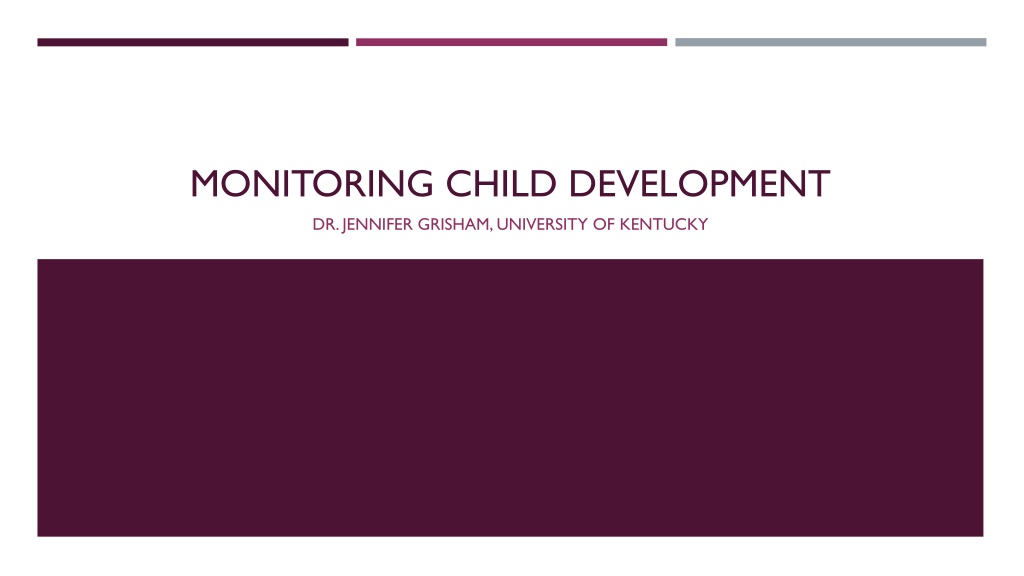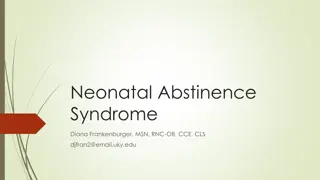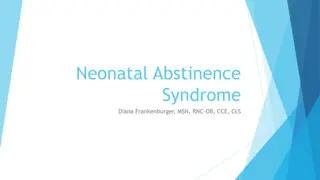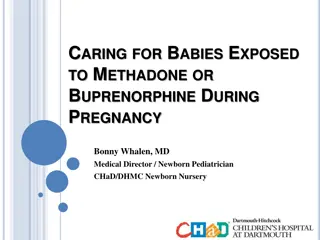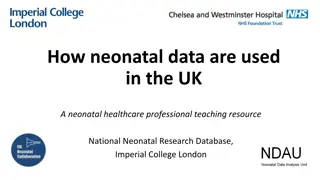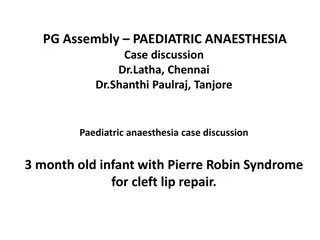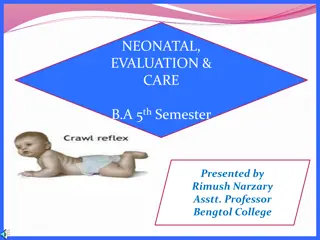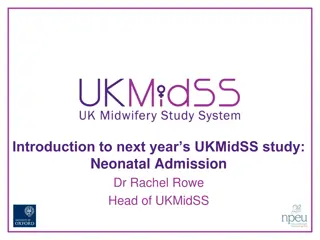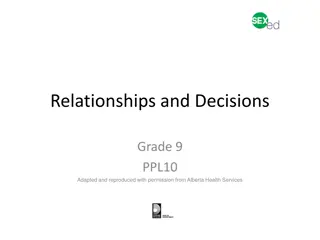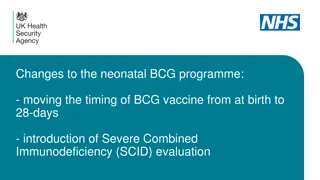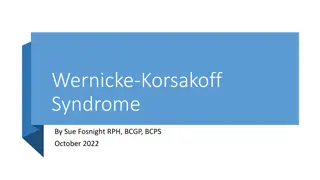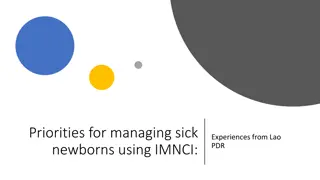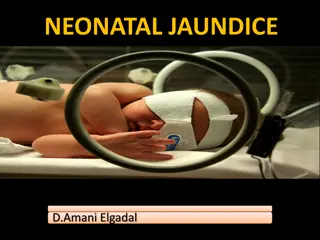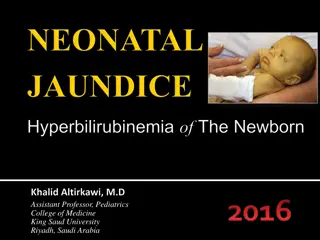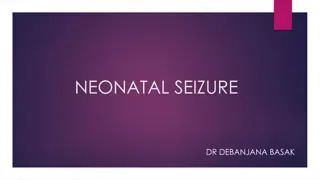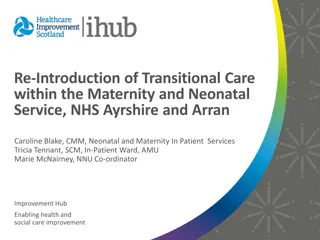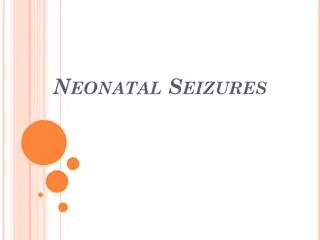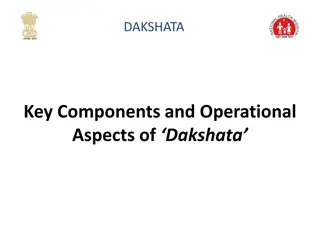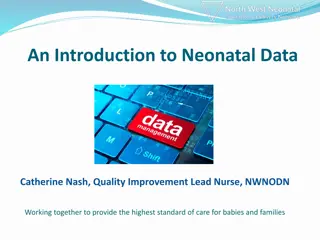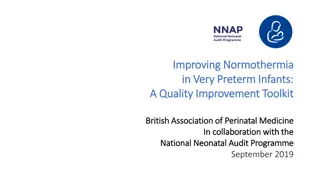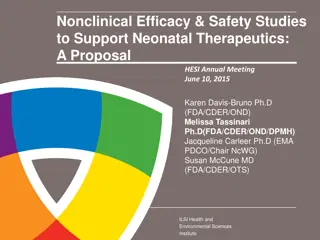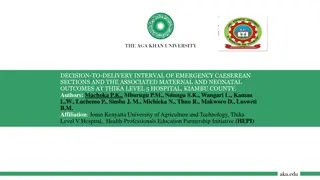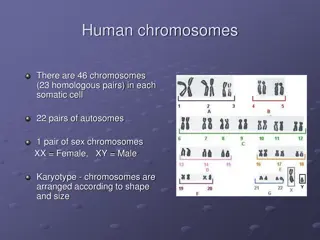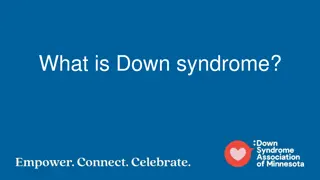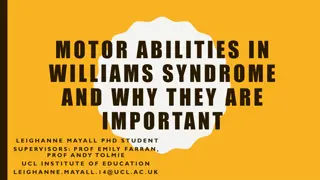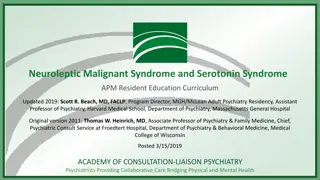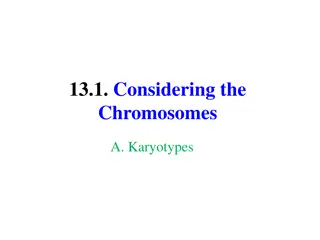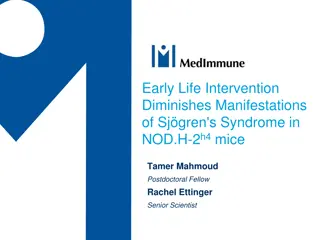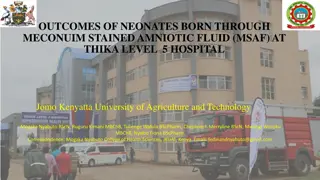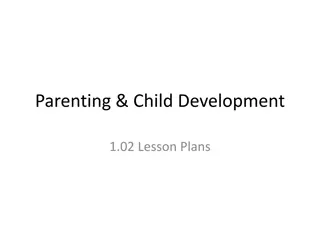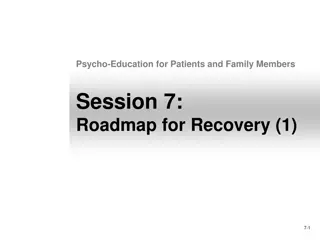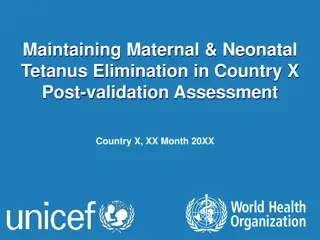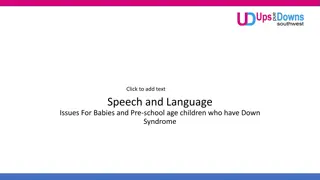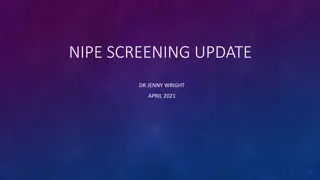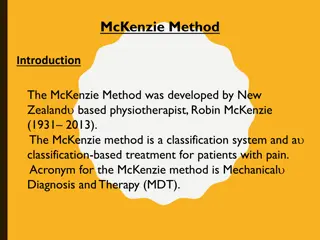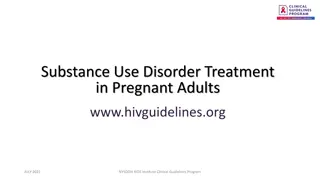Understanding Child Development and Assessment in Neonatal Abstinence Syndrome
This presentation discusses the importance of progress monitoring, strategies for assessing children with Neonatal Abstinence Syndrome (NAS), and developmental outcomes assessment needs. It covers topics such as prematurity assessment, physical well-being evaluation, cognitive development, and motor development in infants with prenatal opioid exposure. The content emphasizes the significance of identifying developmental delays and implementing appropriate monitoring strategies for optimal child development.
Download Presentation

Please find below an Image/Link to download the presentation.
The content on the website is provided AS IS for your information and personal use only. It may not be sold, licensed, or shared on other websites without obtaining consent from the author. Download presentation by click this link. If you encounter any issues during the download, it is possible that the publisher has removed the file from their server.
E N D
Presentation Transcript
MONITORING CHILD DEVELOPMENT DR. JENNIFER GRISHAM, UNIVERSITY OF KENTUCKY
OBJECTIVES Participants will identify the importance of progress monitoring in identifying developmental delays in children with NAS and following their developmental progress Participants will identify strategies used for assessing young children with NAS Participants will apply new knowledge of progress monitoring strategies to case example
Prematurity Assessment of physical well- being Motor, Language, & Cognitive Delays (memory & problem solving) Neurodevelopmental assessments of developmental delays Behavior disorders Psycho-behavioral assessments to identify hyperactivity and ADHD Childhood trauma Family assessment to identify support needs Visual defects Ophthalmological assessment for visual defects DEVELOPMENTAL OUTCOMES AND ASSESSMENT NEEDS
ASSESSMENT OF PHYSICAL WELLBEING - NEONATAL ABSTINENCE SCORING SYSTEM (FINNEGAN & KALTHENBACH, 1992) Central Nervous System Disturbances (e.g., tremors, increased muscle tone) Metabolic/Vasomotor/Respiratory Disturbances (e.g., sweating, nasal flaring) Gastrointestinal Disturbances (e.g., poor feeding, loose stools)
COGNITIVE DEVELOPMENT Infant-Toddler A systematic review & meta analysis observing cognitiveand motor outcomes of childrenwith prenatal opioid exposure looking at children 6-24 months81 Data pulled from 13 studies, 584 children with prenatal exposure, and 1496 controls Analysis revealed a significant difference in neurocognitive development, with children with prenatal exposure performing lower (d= -0.52; P<.001) Follow up study of 149 children maternal marijuana use (n=38); maternal cocaine (n=35); maternal methadone maintenance (n=24); and controls (n=49)177 Administration of the Bayley at 18-24 months methadone group had significantly lower cognitive scores compared to other groups (p< .05) 5
MOTOR DEVELOPMENT Motor Skills in Infancy: Some commonlyreported atypical motor outcomes include: Atypical motor patterns during first year of life including writhing and fidgety movements181 Increased occurrence of torticollis213 Higher incidence of atypical neurologic examinations 177 For infants in the withdrawal process, hypertoniacan lead to exaggerated back arching as the bodymoves into extension. Swaddling and non-nutritive sucking can help decrease these pronouncedand atypical bodypositions. 6 6
SPEECH & LANGUAGE DEVELOPMENT Long Term Outcome (Birth to 10) A recently published longitudinal study observed the presence of language delays in children during their first 10 years of life (birth, 1, 5, and 10 year data) comparing children with NAS and a "high risk" control group214 Sample: 658 Children with NAS and 730 non-exposed controls At 1 year follow up 65% of childrenwith NAS hadlanguagedelay, comparedto 74% of children withoutNAS At 5 year follow up 81% of childrenwith NAS hadlanguagedelay, comparedto 82% of children withoutNAS At 10 year follow up 24% of children with NAS had languagedelay, compared to 12% of children without NAS What this suggests- ChildrenwithNAS hada significantlydifferent patternof languagedelay over time, whichcalls for increased needfor developmentalsurveillancethroughoutearly andmiddlechildhood. "This seems counterintuitive; however, it is possible that the elevated rates of language delays are related to the high-risk sample. For the current study, nearly 77% of the sample experienced in utero polysubstance (varying combinations of tobacco, alcohol, cocaine, opioids, and marijuana) exposure, with 79.5% of the NAS group and 73.6% of the non-NAS group exposed to substances in utero. 7
DEVELOPMENTAL ASSESSMENTS FOR DEVELOPMENT DELAYS Screening Ages and Stages Questionnaire Diagnosis Bayley Scales of Infant and Toddler Development III (language, motor, and cognition) Program Planning and Progress Monitoring Assessment, Evaluation, and Program System (AEPS) Carolina Curriculum Hawaii Early Learning Profile
AGES AND STAGES QUESTIONAIRES-3 FEATURES For children birth to 5 Completed by parent in 2-3 minutes Can be re-administered every 2 months Online option Largest norm population for a screener over 12,000 Available in English, Spanish, & French Includes learning activities
BEHAVIOR Infant Some studies on early behavioral differences suggest infants with NAS/prenatal opioid exposure may experience difficulties with behavior during infancy58, 72 Infant behavioral differences Include: Showing a negative affect Decreased self-regulation Increased sensory seeking behaviors 1 0
BEHAVIOR Toddler/Preschool Retrospective chart review (n=87) from a NICU follow up clinic of children with NAS. At 2 year visit, 26% of families reported significant behavioral or sleep difficulties1 Including: tantrums, hyperactivity, sensory issues, and difficulty falling/staying asleep. Systematic review of 5 articles observing neurobehavioral consequences of chronic intrauterine opioid exposure in infants/preschoolers96 Five areas analyzed: growth, perceptual, emotional, intellectual, and behavioral capabilities. Non-significant difference in performance compared to controls, however children with prenatal exposure had poorer trends in all domains assessed. Children born to mothers on buprenorphine maintenance (n=25) completed neurobehavioral testing14 Elevated levels of hyperactivity, impulsivity, attention problems 1 1
CHILDHOOD TRAUMA AND SIGNS OF ITS IMPACT ON YOUNG CHILDREN Physical Abuse Physical Neglect Emotional neglect Sexual Abuse Parental Divorce Domestic violence Substance abuse Suicide attempt of family member Imprisonment of family member Regulation Issues (sleeping and eating) Increased anxiety Aggression Hyperactivity
FAMILY ASSESSMENT TO DETERMINE SUPPORT NEEDS Family/Caregiver Interview Considerations Purpose of interview (i.e., Determine needs of family? Identify goals for child? Determine family s perception of child s progress) Effective communication strategies Signaling openness Reflecting message Intentional inquiry Influencing skills Methods Routines based Skills based
VISION DEVELOPMENT Children with NAS have been observed to have increased risk of negative visual outcomes including: Nystagmus15, 88, 140 Strabismus15, 88, 175 Decreased visual acuity15, 88 Refractive errors88 Cerebral Visual Impairment88 also referred to as cortical visual impairment Delayedvisual maturation140 Failed visual exams130 Why this matters Visual impairment can have a significant impact on a child s development due to the importance of interacting and exploring yourenvironment to learn. Developmental areas that can be impacted include: social skills, motor skills, language acquisition, learning, and independence in daily living skills1 1 4
VISION ASSESSMENT INDICATORS OF CVI Leading cause of visual impairment in first world nations Characteristics: Unusual attention to color Attention to movement Delayed response to visual stimuli Difficulty processing visual information with a lot of clutter Difficulty seeing things in lower visual field Respond best to things they see over and over again not novel things Don t blink when there is a visual threat Difficulty with distance viewing Light gazing Lack of visually directed reach
ADDITIONAL INFORMATION During follow-up, infants with NAS particularly require (1) neurodevelopmental assessments to identify motor deficits, cognitive delays, or relative microcephaly; (2) psycho-behavioral assessments to identify hyperactivity, impulsivity, and attention-deficit in preschool-aged children, as well as school absence, school failure, and other behavioral problems in school aged children; (3) ophthalmologic assessment to identify nystagmus, strabismus, refractive errors, and other visual defects; (4) growth and nutritional assessment to identify failure to thrive and short stature; and (5) family support assessments to exclude continuous maternal substance abuse and child abuse (Kocherlakota, 2014). Failure to use eye movements to predict another person s actions may have negative developmental consequences as a child may have difficulty imitating and learning from others thus affecting social cognition. (NAS PowerPoint from Cincinnati) 16
FACILITATING FAMILY SUPPORT: THE 5 SS The 5 S s stimulate calming in babies: 1) by swaddling them and moving them with up and down movements, 2) by holding them in a side/stomach position, 3) by using a loud shh or white noise sounds, 4) by swinging them with small jiggling motions with support to head, and 5) by promoting sucking behaviors. (Harrington et al., 2012; Karp, 2002)
REFERENCES/RESOURCES Beckwith, A. M., & Burke, S. E. (2015). Identification of early developmental deficits in infants with prenatal heroin, methadone, and other opioid exposure, Clinical Pediatrics, 54(4), 328-335. Burke Harris, N. (2018). The deepest well: Healing the long-term effects of childhood adversity. Harrington, J., Logan, S., Harwell, C., Gardner, J., Swingle, J., McGuire, E., & Santos, R. (2012). Effective Analgesia Using Physical Interventions for Infant Immunizations. Pediatrics, 129, 815 82. Jansson, L. M., & Patrick, S.W. (2019). Neonatal Abstinence Syndrome. Pediatric Practices of North America, 62(2), 353-368. Karp, H. (2002). The happiest baby on the block. NY: NY. Bantam. Kocherlakota, P. (2014). Neonatal Abstinence Syndrome, Pediatrics, 134(2): p.e-547-e-561. doi:10.1542/peds.2013-3524 Konijnenberg, C et al. (2012). A Melinder, Neurodevelopmental Investigation of the Mirror Neuron System in Children of Women receiving Maintenance Therapy during Pregnancy, Addiction Res Report. Rodr guez, J. J., & Smith, V. C. (2018). Prenatal Opioid and Alcohol Exposure: Understanding Neonatal Abstinence Syndrome and Fetal Alcohol Spectrum Disorders to Safeguard Maternal and Child Outcomes.ZERO TO THREE,38(5), 23 28.
